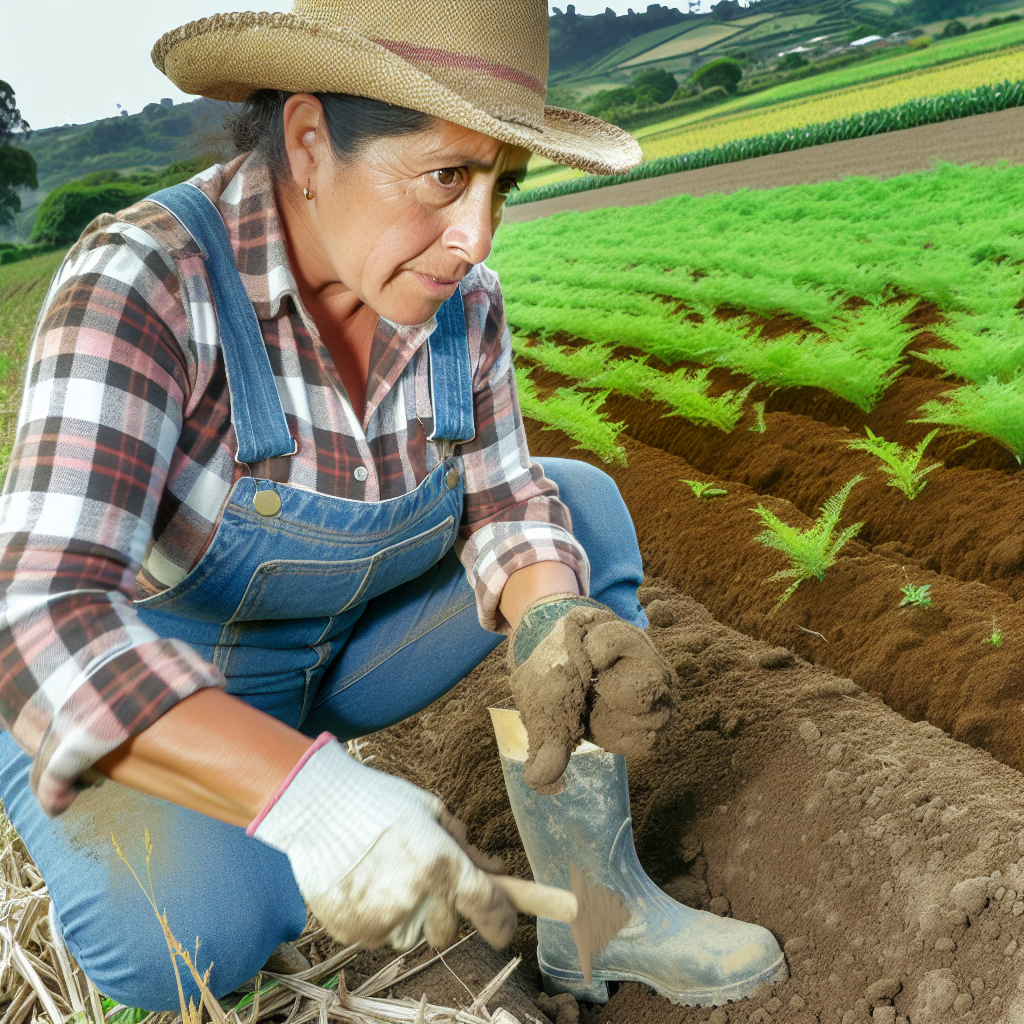Understanding Soil Ecosystems
Importance of Soil Health
Soyl health plays a critical role in agriculture.
Healthy soil enhances crop productivity and sustainability.
It also acts as a natural filter for water quality.
Furthermore, soil supports a diverse ecosystem of organisms.
This biodiversity improves nutrient cycling and resilience.
Role of Microorganisms
Microorganisms are vital for maintaining healthy soil.
They decompose organic matter, releasing nutrients back into the soil.
These organisms also help improve soil structure and aeration.
In addition, they form symbiotic relationships with plants.
Such relationships boost nutrient uptake and disease resistance.
Soil Composition and Structure
Healthy soil comprises minerals, organic matter, water, and air.
The balance of these components determines soil quality.
Clay, silt, and sand influence the soil’s texture and drainage.
Good soil structure fosters root growth and moisture retention.
Ultimately, proper soil composition supports agricultural productivity.
Transform Your Agribusiness
Unlock your farm's potential with expert advice tailored to your needs. Get actionable steps that drive real results.
Get StartedImpact of Soil Management Practices
Soil management practices significantly affect soil health.
Conservation tillage reduces soil erosion and disturbance.
Crop rotation promotes nutrient diversity and soil structure.
Adding organic matter enhances soil fertility and microbial activity.
Moreover, cover crops can prevent nutrient runoff and erosion.
Key Nutrients for Soil Health on Heritage Farms
Understanding Soil Nutrients
Soil health relies heavily on its nutrient content.
Essential nutrients include nitrogen, phosphorus, and potassium.
These elements play crucial roles in plant growth.
Additionally, calcium, magnesium, and sulfur contribute to soil health.
Nitrogen: The Growth Booster
Nitrogen is vital for plant tissue development.
It promotes lush green foliage and overall plant vigor.
Farmers can enhance nitrogen levels using cover crops.
Legumes, such as clover, naturally fix nitrogen into the soil.
Phosphorus: Root Development Essential
Phosphorus supports strong root systems in plants.
It also aids in flower and fruit development.
Rock phosphate is a common natural source of phosphorus.
Moreover, compost can increase phosphorus availability.
Potassium: Enhancing Resilience
Potassium improves a plant’s ability to withstand stress.
It regulates water usage and promotes disease resistance.
Banana peels and wood ashes can be excellent potassium sources.
Secondary Nutrients and Micronutrients
Besides the major nutrients, secondary nutrients play important roles.
Calcium strengthens cell walls and promotes root growth.
Magnesium is crucial for photosynthesis.
Sulfur supports chlorophyll formation and protein synthesis.
Showcase Your Farming Business
Publish your professional farming services profile on our blog for a one-time fee of $200 and reach a dedicated audience of farmers and agribusiness owners.
Publish Your ProfileMicronutrients such as iron and zinc are also essential.
These elements are important for various physiological functions.
Balancing Nutrients for Optimal Health
Maintaining a balanced nutrient profile is essential.
Soil testing helps determine nutrient levels accurately.
Farmers should apply amendments based on test results.
Regular monitoring ensures sustainability and productivity.
The Role of Organic Matter in Enhancing Soil Quality
Understanding Organic Matter
Organic matter consists of decomposed plant and animal materials.
It plays a vital role in maintaining soil health.
This component enhances the physical, chemical, and biological properties of soil.
Improving Soil Structure
Organic matter improves soil structure significantly.
This enhancement leads to better aeration and drainage.
Good soil structure also encourages root growth.
Furthermore, it helps to reduce soil compaction.
Enhancing Nutrient Retention
Organic matter increases the soil’s capacity to retain nutrients.
It helps bind essential minerals allowing plants to access them.
This retention promotes healthy plant growth and development.
Supporting Microbial Activity
Healthy soil contains a diverse community of microorganisms.
Organic matter provides essential food for these microbes.
In turn, they assist in breaking down organic materials.
This process releases nutrients necessary for plant growth.
Water Retention Benefits
Organic matter improves soil’s water-holding capacity.
It helps maintain moisture during dry periods.
This quality is crucial for sustainable farming practices.
Contributing to Carbon Sequestration
Organic matter plays a key role in carbon sequestration.
It captures carbon dioxide from the atmosphere into soil.
This capture helps mitigate climate change effects.
Implementing Organic Matter in Farming Practices
Farmers can enhance soil health by adding organic matter.
This can be done through compost, cover crops, or green manures.
Regularly incorporating organic materials leads to long-term soil improvement.
Learn More: Step-by-Step Mushroom Cultivation for Farmers
Crop Rotation: A Strategy for Sustainable Soil Management
Defining Crop Rotation
Crop rotation involves alternating the types of crops grown in a specific area.
This practice enhances soil fertility and reduces pest buildup.
Farmers often implement rotations seasonally or annually to maximize benefits.
Benefits of Crop Rotation
Crop rotation significantly improves soil health over time.
It decreases soil erosion by promoting diverse root systems.
Diverse crops can also reduce the risk of soil nutrient depletion.
This method helps control pests and diseases naturally.
Farmers may notice improved yields as a result of healthier soil.
Implementing a Crop Rotation Plan
Creating an effective crop rotation plan requires careful consideration.
Farmers should first analyze soil types and nutrient needs.
Showcase Your Farming Business
Publish your professional farming services profile on our blog for a one-time fee of $200 and reach a dedicated audience of farmers and agribusiness owners.
Publish Your ProfileNext, they can select crops that complement each other’s growth.
Additionally, timing is crucial in scheduling planting and harvesting.
Examples of Successful Crop Rotations
One classic rotation includes maize, soybeans, and wheat.
In this rotation, each crop benefits from the previous one’s growth.
Another example is the practice of growing legumes followed by grains.
Legumes enhance nitrogen levels, improving the soil for grains.
Monitoring and Adjusting the Rotation
Regular monitoring is essential to gauge crop performance.
Farmers should take notes on yield, soil quality, and pest populations.
If issues arise, adjustments to the rotation may be necessary.
You Might Also Like: Seasonal Tips for Year-Round Mushroom Cultivation
Conservation Tillage Practices: Benefits and Techniques
Understanding Conservation Tillage
Conservation tillage focuses on minimizing soil disturbance.
This practice enhances soil health and structure.
Farmers utilize various methods to reduce tillage intensity.
As a result, they improve water retention and nutrient availability.
Benefits of Conservation Tillage
One primary benefit is the reduction of soil erosion.
Cover crops play a crucial role in this process.
They protect the soil surface and add organic matter.
Furthermore, conservation tillage enhances biodiversity.
This approach supports various microorganisms in the soil.
Techniques for Effective Implementation
Farmers can employ several techniques for effective conservation tillage.
- No-till: This method involves planting without previous soil preparation.
- Strip till: It combines tillage in specific rows and leaves the rest undisturbed.
- Reduced till: This approach limits tillage operations, maintaining soil integrity.
Choosing the Right Method
Selecting the appropriate conservation tillage method depends on various factors.
These factors include soil type, crop selection, and climate conditions.
Farmers should consider their individual farm goals and resource availability.
By making informed decisions, they can optimize soil health.
Success Stories in Heritage Farming
Many heritage farms have successfully adopted conservation tillage.
For example, the Greenfield Family Farm has seen improved yields.
They implemented no-till strategies that enriched soil quality.
Consequently, they have enhanced water conservation on their fields.
Such success stories inspire other farmers to adopt similar practices.
Uncover the Details: Growing Vegetables In Urban Environments
Cover Cropping: Protecting Soil and Promoting Biodiversity
Benefits of Cover Cropping
Cover cropping offers numerous benefits for soil health.
First, it reduces soil erosion caused by wind and rain.
Additionally, cover crops enhance soil structure over time.
Furthermore, they help retain moisture in the soil.
This moisture retention is crucial during dry spells.
Moreover, cover crops improve nutrient cycling in the soil.
They can fix nitrogen, enriching the soil naturally.
Also, they serve as habitat for beneficial insects.
This promotes biodiversity on the farm.
Types of Cover Crops
Choosing the right cover crop is essential.
Showcase Your Farming Business
Publish your professional farming services profile on our blog for a one-time fee of $200 and reach a dedicated audience of farmers and agribusiness owners.
Publish Your ProfileLegumes are a popular option for nitrogen fixation.
Species like clover and vetch work effectively.
Cereal grains, such as rye and oats, are useful as well.
They provide ground cover and suppress weeds.
Farmers can combine different species for optimal benefits.
This practice is known as polyculture cover cropping.
Implementing Cover Cropping Practices
Implementing cover cropping requires careful planning.
Farmers should assess their soil type and climate.
Next, they need to determine the best planting time.
Cover crops are usually sown in fall after harvesting.
Also, farmers should establish a termination plan for cover crops.
Common methods include mowing or using herbicides.
Proper termination ensures that cover crops are effective.
Challenges and Considerations
Despite the many benefits, challenges exist in cover cropping.
One challenge is the initial investment in seeds and equipment.
Farmers must also consider the potential for weeds.
Effective management reduces weed competition.
Additionally, some cover crops may attract pests.
Farmers should monitor pest activity closely.
Overall, education and experience can lead to success.
Delve into the Subject: Benefits of Organic Farming for the Environment

Natural Amendments: Using Compost and Manure for Soil Enrichment
Benefits of Natural Amendments
Natural amendments enhance soil structure and fertility.
They boost microbial activity and nutrient availability.
Furthermore, they help in water retention.
Compost and manure enrich soil with essential nutrients.
Understanding Compost
Compost is organic material that decomposes over time.
This process transforms waste into a valuable resource.
Homeowners and farmers can create compost from kitchen scraps.
Common compost materials include leaves, grass clippings, and vegetables.
Mixing green and brown materials creates a balanced compost.
How to Create Compost
Start by selecting a compost bin or pile location.
Layer brown and green materials for optimal decomposition.
Regularly turn the pile to aerate and speed up the process.
Keep the compost moist but not soggy.
In about 3 to 6 months, compost is ready to use.
Exploring Manure
Manure is a nutrient-rich organic fertilizer.
It comes from various animals like cows, horses, and poultry.
Using manure improves soil fertility and structure.
It releases nutrients slowly, providing lasting benefits.
Application Methods for Manure
Manure can be applied directly or composted first.
Showcase Your Farming Business
Publish your professional farming services profile on our blog for a one-time fee of $200 and reach a dedicated audience of farmers and agribusiness owners.
Publish Your ProfileDirect application should be done according to soil tests.
Composting manure minimizes odors and pathogens.
Spread it evenly to avoid nutrient overload in specific spots.
Using Both Amendments Together
Combining compost and manure maximizes benefits to soil health.
This combination balances nutrients and enhances microbial life.
Apply them according to crop needs and soil conditions.
Monitor soil health regularly to adjust applications.
Soil Testing and Monitoring: Assessing Soil Health Regularly
Importance of Soil Testing
Regular soil testing is vital for maintaining soil health.
It provides insights into nutrient availability and deficiencies.
This knowledge helps farmers make informed decisions.
Ultimately, it boosts crop yields and sustainability.
Choosing the Right Testing Methods
Several soil testing methods exist to choose from.
Laboratory tests offer comprehensive insights into soil composition.
On-site kits provide quick results for immediate decisions.
Farmers should select methods that fit their specific needs.
Creating a Soil Testing Schedule
Developing a soil testing schedule is essential for consistency.
Test soil before planting, during growth, and post-harvest.
This routine helps track changes in soil health over time.
Regular testing aids in adjusting management practices as needed.
Interpreting Soil Test Results
Understanding test results is key to actionable decisions.
Farmers should get a professional interpretation if needed.
Focus on nutrient levels, pH, and organic matter content.
This information guides fertilization and amendment practices.
Monitoring Soil Health Indicators
Soil health indicators provide a broad view of soil condition.
Indicators include earthworm activity and microbial diversity.
Visual assessments also play a role in monitoring health.
Regular observations can signal potential issues early on.
Adapting Practices Based on Findings
Use soil test results to adapt agricultural practices.
Modify fertilization based on nutrient content in soil.
Consider crop rotation to enhance soil diversity and health.
Continually evaluating practices fosters long-term soil vitality.
Pest Management Strategies that Support Soil Health
Understanding Integrated Pest Management
Integrated Pest Management (IPM) promotes sustainable practices in farming.
This approach combines biological, cultural, and mechanical methods.
By using IPM, farmers can reduce reliance on chemical pesticides.
Consequently, soil health improves as beneficial organisms thrive.
Utilizing Cover Crops
Cover crops protect soil from erosion during off-seasons.
They also suppress weed growth, thus reducing pest habitats.
Moreover, cover crops enhance soil structure and nutrient content.
Common examples include clover, rye, and legumes.
These plants fix nitrogen, enriching the soil for future crops.
Showcase Your Farming Business
Publish your professional farming services profile on our blog for a one-time fee of $200 and reach a dedicated audience of farmers and agribusiness owners.
Publish Your ProfileEncouraging Beneficial Insects
Beneficial insects play a crucial role in pest control.
Predators such as ladybugs and lacewings alleviate pest populations.
Planting flowering plants attracts these helpful insects.
This strategy minimizes chemical interventions while boosting biodiversity.
Implementing Crop Rotation
Crop rotation disrupts the life cycles of pests and diseases.
By alternating plant families, soil nutrient depletion slows.
This practice promotes a diverse soil ecosystem, enhancing resilience.
Farmers should plan rotations based on crop compatibility and pest history.
Establishing Organic Mulching
Organic mulching offers multiple benefits for soil health.
It retains moisture and suppresses weeds effectively.
Additionally, as mulch decomposes, it enriches the soil.
Farmers can use materials like straw, wood chips, or grass clippings.
Monitoring and Regular Assessment
Continuous monitoring of pest populations is vital.
Farmers should regularly assess field conditions and pest activity.
This data allows for timely interventions that protect soil health.
Employing traps and observation techniques can facilitate this process.
Educating and Engaging the Community
Community engagement enhances pest management efforts.
Farmers can share knowledge and strategies through workshops.
Collaborative efforts strengthen local agricultural practices.
Furthermore, educated communities are better equipped to support sustainable farming.
The Impact of Sustainable Farming Practices on Soil Preservation
Importance of Soil Health
Soil health is vital for sustainable agriculture.
It supports plant growth and ecosystem balance.
Healthy soil retains moisture and nutrients effectively.
Additionally, it enhances biodiversity and resilience.
Practices Promoting Soil Health
Sustainable farming incorporates various practices.
Crop rotation is essential for preventing depletion.
It helps maintain nutrient levels in the soil.
Cover cropping protects the soil from erosion.
This practice also increases organic matter content.
Reducing Chemical Dependency
Sustainable methods minimize chemical fertilizer use.
Organic fertilizers promote microbial activity.
Moreover, they reduce the risk of soil contamination.
Farmers benefit from healthier crops and reduced costs.
Enhancing Soil Structure
Maintaining soil structure is crucial for cultivation.
Conservation tillage preserves soil integrity.
It minimizes erosion and compaction issues.
This practice encourages water infiltration and root development.
The Role of Agroforestry
Agroforestry practices integrate trees with crops.
This diversification improves soil quality significantly.
Trees enhance nutrient cycling and soil moisture retention.
Showcase Your Farming Business
Publish your professional farming services profile on our blog for a one-time fee of $200 and reach a dedicated audience of farmers and agribusiness owners.
Publish Your ProfileMoreover, they act as windbreaks, reducing erosion.
Long-Term Benefits
Implementing sustainable practices ensures long-term soil health.
This approach fosters resilience against climate change.
Consequently, farms remain productive and viable for generations.
Healthy soil contributes to overall food security.
Additional Resources
Equity in Conservation Outreach Projects 2023 | Natural Resources …




